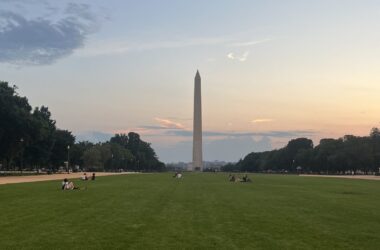As we have probably all noticed at some point, current fashions often conflict. While everyone is still flapping about flats and their newly wistful attitude to life and walking, Pam Anderson-inspired monstrosities are somehow attaching themselves to all my friends’ feet. As fashion always manages to permeate every facet of life, why not procreation?
Last spring, pregnant women appeared to be popping up like crocuses out of sidewalk cracks. It wasn’t just me that noticed-being in the family way had become a thing of haute couture. I can recall a friend exclaim, “I kind of want to be pregnant so I can wear all those cute clothes too.”
And just like flats from last year, the pregnancy party rocked on into this year: Brangelina took it offshore, creating an elite, Swiss bank account brand of pregnancy.
But not everyone is breathing to the same Lamaze rhythm. During a recent trip to East Africa with 37 other undergrads, I was shocked at the proportion of my fellow female students that had absolutely no plans to ever have children. The majority seemed to feel that the world was in a state of dismay too wretched to ignore by becoming preoccupied with a smaller version of themselves. The fashion of Brangelina had obviously come to clash with that of the female undergrad. And to think that both camps are trying to save the world.
But are babies just the latest celebrity treat, like J-Brand jeans? Hardly.
While researching maternal health throughout East Africa, I had the chance to speak with many a Maasai midwife. A response I got from one particular woman struck me: When asked about abortion, an elderly woman turned to me, stared me straight in the face and slowly said, “Maasai women love children too much not to have them.” I at once felt two inches tall and miles away from anything remotely maternal. I felt infinitely excluded from the mystical web of connections with the world of children that this woman seemed to draw before me and, if possible, personify.
The futility of it all wouldn’t leave me: On one end of the spectrum is Denise Richards, buying designer merchandise for her little ones and posing in revealing tops just “three weeks after giving birth,” while on the other end are Maasai women who regard love, need and desire for children with the same inherency as eating or breathing. Stuck blandly in the middle is an entire generation of intelligent young women who-because of the vast discrepancy between these two polar ends of the maternity and global socio-economic spectrum-are forfeiting, often as a result of having been made completely unaware of, their own maternal desires.
Our glamourization of pregnancy has led many career-oriented women to regard motherhood as anti-feminist; the pit of domesticity and materialism into which you plummet if you fail to make it in the world. Not until the Maasai midwife’s words did I pause to consider motherhood as unquestionable and acceptable: Capable of existing without eggshell blue walls, maternity wear or Brooke Shields’ book on post-partum depression; without all the baggage that we feel the need to attach to it.
Furthermore, does it really make sense-if we are aiming for the sacrificial type of life-to renounce a family in order to help these Maasai communities when family is at their essence? It seems as though we’re moving farther away from understanding each other, and closer to simply imposing our views on a people we purport to understand because we gave up kids for them. Forgive me for saying this, but when it comes to understanding the essential elements of a Maasai woman’s life, baby-magnet Denise Richards might fare better than many of my fellow students.








